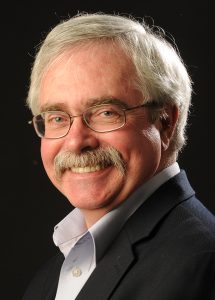News literacy and engagement are becoming a global affair

(Note: This is a guest post by John Moore, who retired as editor of the Ventura County Star in California in April 2017 after more than 50 years in journalism.)
My standard stump speech to community groups about five years ago included the line that the competition for our news organization was everyone in that room because everyone had become a publisher.

John Moore
- I was more right than I wanted to be.
The explosion of information sources is drowning common sense in our world as we try to sort out what is true, what is false and who we can reliably trust as our go-to source. Those of us from the inside of the news business feel comfortable in identifying properly reported and written information. But we know, simply from listening to our communities, that is more and more difficult today for even the best news consumer to know how to tell the difference.
A goal of my stump speech back then was to preserve subscribers and advertising. Today it is to preserve our rights and our freedoms.
That’s why I am so excited by the work being done here at News Co/Lab to highlight the best ideas and practices helping our citizens develop news literacy.
The World Association of Newspapers and News Publishers with the American Press Institute has compiled a database of some of the global work being done to encourage news literacy. It is part of the excellent report “Youth & News Media Report” authored by Aralynn McMane.
Many of the ideas in the database of more than 100 examples from around the world are similar to our traditional Newspaper In Education programs (which too many organizations abandoned when the cutting torches were turned on) and in support of journalism education programs.
Here are a few of the examples from that list that I found particularly intriguing. (The descriptions of the programs come directly from the WAN-IFRA database.)
Argentina: SIMULATION AT MUSEUM — “Grupo El Clarín has an interactive space at the Childrens´ Museum in Buenos Aires, where children learn through play how the newspaper is developed, how to create comic strips and how to write a news story. This is all done via interactive software, that even allows them to take home a printed copy of their work. The exhibition also allows them to play sports, and experience being ‘sports announcers’ in a booth with microphones and special effects. Over 450,000 kids visit the exhibition yearly.” Most of our cities, and many smaller towns, pride themselves in their children’s museum. This does not solve our “fake news” battles, but it seems like a fairly easy and not terribly expensive way to introduce young children to the business of gathering news, helping a few discover the passion that pulled many of us into this business.
Belgium: JOURNALIST VISITS AND GUIDE, — “Organizes visits for journalists to classes of 10- to 11-year-olds after teachers use materials provided by the Associationdes Journalistes Professionnels (Association of Professional Journalists) to examine how journalists work. The association has also created a guide for the journalists.” This is similar to the Learn By Doing project from Journalistic Learning Initiative listed on the Best Practices pages here. Journalists around our country are volunteering to speak in classrooms about our craft. I like the idea of coordinating an in-class curriculum with those visits. And it might be useful for someone to prepare a guide to help the journalists (most of whom are not educators) be better prepared to make those presentations.
Belgium/Flanders: BEST BOOK MASTER READING TEACHER – “This contest calls for ‘bottom up’ nominations of primary schoolteachers who are effective at instilling a love of reading and skills in literacy. Journalists then interview the nominated teachers. An annual magazine describes these good practices.” There are some amazing programs being created in schools across our country related to news literacy. It would be wonderful to have a contest to recognize, honor and share the best of those practices.
Chile: INTERVIEW FESTIVAL — “In this national interview contest children ages 7 to 12 submit 10 questions intended for a public figure. The best three get to interview the person. The interview is recorded on video and also printed in newspapers. The contest has been going on since 2001. The association receives an average of 5000 submissions yearly. This activity inspired a similar contest for Hungary and, in part, WAN-IFRA’s global My Dream Interview Festival. The educational organization educarchile.cl created a teacher guide and tools for teachers to use media in their classrooms.” It’s another contest, but one that can be scaled from national to state, regional or local levels. Anything we can do to help young people learn how to ask the right questions is worth our investment.
Europe (Netherlands, then Belgium, Germany, Sweden): MEDIA COACH – “Begun in The Netherlands, this is a transnational initiative (also in Belgium, Sweden and Germany) of media resource centres in Europe that offer media literacy training opportunities for teachers, teacher training colleges, libraries and social community centres. In Belgium, it is supported by publishers association. Model possibly useful for media associations though Dutch association has some reservations about it.” The endorsement and support of national media organizations might be a way to broaden and scale the efforts of existing programs like the Journalistic Learning Initiative or the News Literacy Project.
France: MOVING NEWSSTAND – “The Albert Londres foundation in Marseille created a moving tent-style newsstand-reading room around poorer areas of the city, stocked with magazines and newspapers that children can sit and read. The volunteers also provide refreshments and chairs for discussing the news.” We should probably admit that the subscription booths and tables we set up at every weekend fair and event across the country are not getting quite the same return as they did in the good ol’ days. Maybe it’s time to rethink that space and utilize it for a program like this.
Ireland: PRESS PASS – “Working as a group on news literacy came late to Irish publishers. While several had their own project, it was not until 2012, with WAN-IFRA’s encouragement, that they decided to do something together. The result was the ‘Press Pass’ national media literacy project conceived by Enda Buckley that includes a very slick news literacy workbook targeting 16-year-olds and culminates in a major national youth journalism contest. The work is sponsored by the Irish League of Credit Unions.” This is one of the better national youth news literacy programs similar to those created by the great folks at the News Literacy Project and elsewhere. There are some good ideas here worth borrowing.
Netherlands: THE FREEDOM OF EXPRESSION ROADSHOW — “Teachers get a packet to go over with students covering the vocabulary of news, the function of news in a democracy, national and international regulations and limitations to freedom of speech and of the press. The goal is safe debate. Children get to play dictator and cut from local newspapers all content they don’t like. Then a visiting journalist comes to talk with them about all of it.” This is another specific curriculum for teachers, and one that incorporates visiting journalists. I was intrigued by it because it would allow us to talk about what censorship looks like and what impact it would have on our freedoms.
Norway: ETHICS ACTIVITY – “The association mixed video and interactive voting to allow teenagers ages 15 to 19 to play the role of editor around some ethical issues spanning all mediums from newspapers, TV, radio, online and social media. One activity, inspired by the Norwegian Press Complaints Commission, explores ethics by asking participants questions like “would you publish this?” for which they vote using red (NEI) or green (JA) paper. An app allows online voting, then students can watch the same ethical dilemmas in a discussion between three teens and three editors guided by a prominent commission personality.” I am a believer that we do not do a good enough job in explaining the ethical discussions and decisions that get made in our newsrooms on a daily basis. Anything we can do to help explain that, and show the types of options that are available, is worth exploring.
My brief meandering through the idea bank of journalists, journalistic organizations and educators around the world was heartening. There are many others who have taken up this cause.
